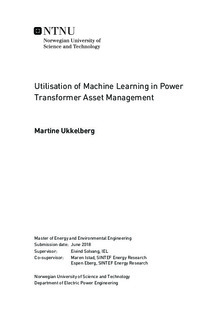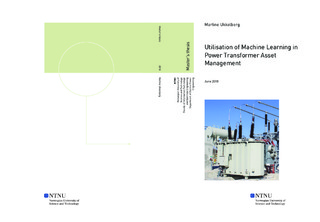| dc.description.abstract | Ageing assets in the power system increase the need for maintenance and reinvestments. There is currently a shortage of adequate data and analysis systems available for estimation of condition and remaining lifetime, to facilitate decision-making. It is a challenge to restructure asset management with regard to collecting relevant data and to introduce new systems for handling and analysing the data. There is a large potential for increased value creation through more online and automatic collection and analysis of condition values.
This thesis examines potential opportunities obtained by better management of big data and utilisation of machine learning for power transformer asset management purposes. Power transformers are expensive and important components of the power system, and an increasing volume of data concerning their condition is becoming available. Transformers also have the potential for longer lifetimes. The introduction of data analysis using machine learning and management of big data enables condition monitoring of components to a greater extent than was previously possible. As a result, power companies can potentially optimise maintenance, and postpone reinvestments by adding resources where needed.
After presenting the theoretical framework, two case studies are performed. A machine learning model was developed to predict transformer hot-spot temperature for a chosen transformer, using available data. Furthermore, predicted hot-spot temperatures were used to estimate winding insulation degradation for different scenarios, including increased load and increased and decreased ambient temperature. These estimates were further used to determine the associated remaining lifetimes. The emerged utility value is also presented.
The results show that machine learning models are able to predict transformer hot-spot temperature with satisfactory accuracy, compared to the hot-spot temperature measured by a fiber optic sensor. The models can also be used to determine the maximum acceptable loading. Change of hot-spot temperature has a large impact on the estimated remaining lifetime, with higher hot-spot temperature leading to accelerated ageing. The predicted hot-spot temperature was also proved to correspond better with the measured hot-spot temperature than the ones obtained by the commonly used loading guide.
Better management of big data and utilisation of machine learning creates many new opportunities. Machine learning can be implemented in already existing activities to increase efficiency and accuracy, and to reduce uncertainty. New applications can also arise as the power system becomes more digital, with emerging use of sensors. Examples are normal behaviour models, sensor verification, and loading determination. Good ICT-structure and data of quality are necessary for these purposes. It is important to emphasise that predictions of condition and lifetime obtained using machine learning are estimates. This needs to be considered when making decisions involving maintenance and reinvestments. | |

